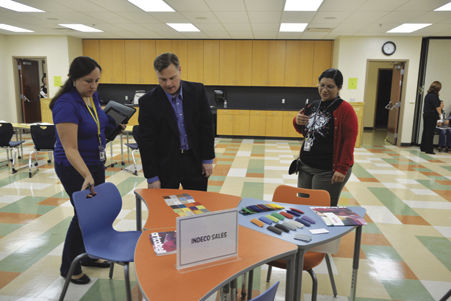HARLINGEN — New furniture soon to arrive at classrooms here will offer endless possibilities for a new approach to learning.
That new approach, known as collaborative learning, refers to a variety of teaching methods that involve groups of students or students and teachers working together on a class project. Many school districts across the country are adopting this new method.
Educational institutions are also espousing this new strategy. The Cornell University website says collaborative learning can occur between two students or in larger groups. Students discuss concepts or solve problems.
“This often occurs in a class session after students are introduced to course material through readings or videos before class, and/or through instructor lectures,” says the website. “Many instructors have found that through peer instruction, students teach each other by addressing misunderstandings and clarifying misconceptions.”
The Harlingen school district has awarded contracts for new desks and chairs which will facilitate collaborative learning.
New technology will include more iPads and will enable teachers and students to project class work onto a 45-inch Apple TV. Teachers will also have a computer from which they can project classroom instruction onto the TV.
Evergreen State College says collaborative learning represents a shift away from the typical teacher centered and lecture centered classroom. Lecturing doesn’t disappear, but it’s integrated with student discussion and interaction with course work.
“Teachers who use collaborative learning approaches tend to think of themselves less as expert transmitters of knowledge to students, and more as expert designers of intellectual experiences for students as coaches or midwives of a more emergent learning process,” says the Evergreen website.
Some sources say there are different types of collaborative learning, one of them being cooperative learning.
The Concept to Classroom website offers a workshop called, “Cooperative and Collaborative Learning.”
In cooperative learning, says the website, students work together in small groups on a structured activity. They are individually accountable for their work, and the work of the group as a whole is also assessed.
The Harlingen school district has emphasized collaborative learning in recent years as part of its Strategic Plan. However, the district’s modernization of the classroom with new technology and furniture now accommodates the approach more directly.
“The tables fit together to create an environment where kids can communicate and work together as a group and share ideas,” said Lorena Rodriguez, a third grade teacher at Travis Elementary.
Once the furniture and new technology arrives, teachers in grades three, four and five will be given a training session to learn how to use them for collaborative learning.
“We have people coming in and training teachers how to use the furniture to enhance their teaching,” said Lori Romero, administrator for elementary education.
Romero said colleges and universities are also adapting the collaborative learning strategy. This kind of learning is necessary because it teaches students how to work together and get along, skills that are crucial in today’s work place.
Romero said businesses have complained that new employees often lack these interpersonal skills.
Different teachers are already discussing ideas on how to use the new furniture and technology. Rodriguez said she has been revising her teaching strategy for a more collaborative approach.
“Here at Travis we’re already talking about how teachers can use the new equipment,” Rodriguez said. “We have been working on lesson plans this year. Teaching is now more interactive. Teachers are more the facilitators.”
What is collaborative learning?
Collaborative learning is based on the view that knowledge is a social construct. Collaborative activities are most often based on four principles:
* The learner or student is the primary focus of instruction.
* Interaction and “doing” are of primary importance
* Working in groups is an important mode of learning.
* Structured approaches to developing solutions to real-world problems should be incorporated into learning.
What is the impact of collaborative learning or group work?
Research shows that educational experiences that are active, social, contextual, engaging, and student-owned lead to deeper learning. The benefits of collaborative learning include:
* Development of higher-level thinking, oral communication, self-management, and leadership skills.
* Promotion of student-faculty interaction.
* Increase in student retention, self-esteem, and responsibility.
* Exposure to and an increase in understanding of diverse perspectives.
* Preparation for real life social and employment situations.




